
JAPANESE PRINTS
A MILLION QUESTIONS
TWO MILLION MYSTERIES
Ukiyo-e Prints浮世絵版画 |
|
formerly
Port Townsend, Washington now Kansas City, Missouri |
|
UTAGAWA TOYOKUNI I 歌川豊国 1769-1825 |
|
Play: Unidentified |
|
Actors: Segawa Rokō IV (1782-1812) - standing (四世)瀬川路考 & Bandō Mitsugorō III (1773-1831) - seated 坂東三津五郎 |
|
Date: 1811 |
|
Signature: Toyokuni ga 署名: 国芳画 |
|
Publisher: Sumimaruya Jinsuke 住丸屋甚助 |
|
Print Size: 13 7/8" x 9 1/4" |
|
Mat Size: 20" x 16" |
|
Condition: Soiling, fading, some abrasions, remnants of old hinges seen on the top left and right corners and four small worm holes in the lower left quadrant. Professionally matted and hinged to museum standards. |
|
ORIGINALLY $110.00 NOW ON SALE FOR $77.00 NO LONGER AVAILABLE! |
|
Our correspondent E was of great assistance in providing information about
this print --- THANKS E! |
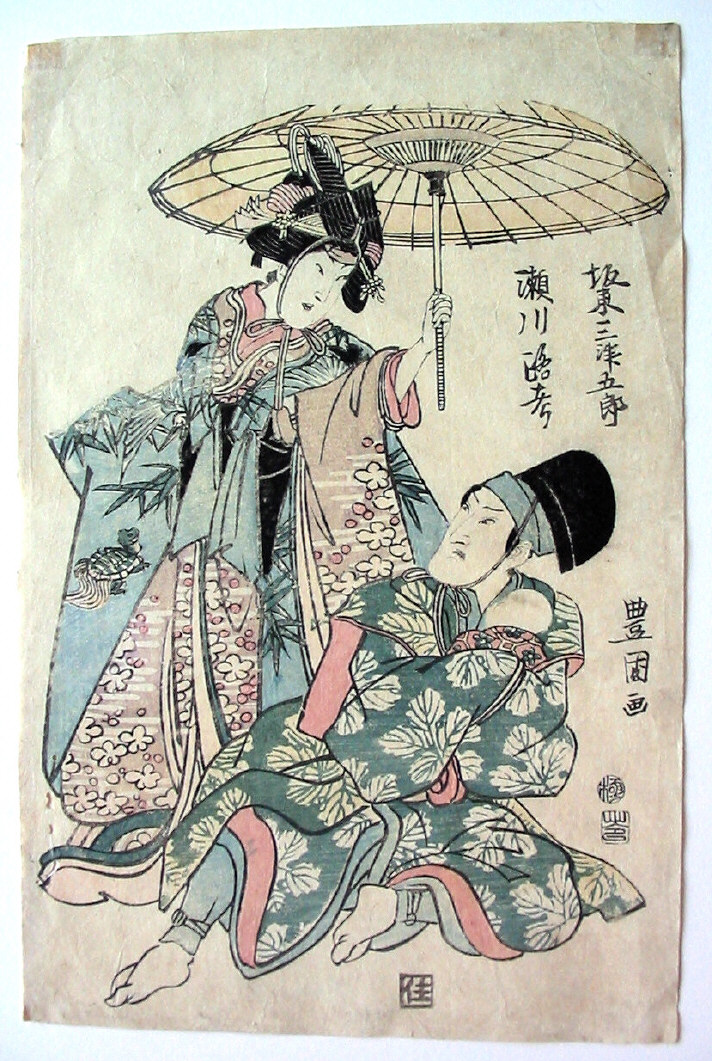
|
TOYOKUNI I RESPECTED IN LIFE MEMORIALIZED IN DEATH |
|
|
|
The history of civilization is the history of its monuments. Many ancient cultures have devoted enormous energies to memorializing their deeds, their gods and their dead. The mysteries of life were followed by the mysteries of death and the two states of 'existence' were inextricably linked. From the Cahokia Mounds near East St. Louis, Illinois to the Valley of the Kings in Egypt to the Taj Mahal diverse and disconnected cultures chose to concentrate many of their best resources on this 'cult of death'. In Japan millions of pilgrims have visited the tomb of Tokugawa Ieyasu in Nikko. But a thousand years before the dedication of Ieyasu's shrine the Japanese were building the elaborate key-shaped tombs of the Kofun period. Undoubtedly this was already an ancient tradition by then. |
|
Detail of an Egyptian pyramid from a print done by Seishu Asahi in 1933 |
|
|
|
Detail of Hiroshi Yoshida's Taj Mahal at Night from 1932 |
|
|
|
And yet grandeur is the exception to the rule. Most of humanity has had to settle for far more modest displays. Everything from unmarked graves to garish sepulchers and mausolea dot our cemeteries. Moreover, these are generally regarded as displays of personal wealth or a lack thereof. They become clear reflections of the reality of what existed in the temporal world and its transition to the other side.
Between the pauper and the Pooh Bah we find everything else. There are the lucky few who touch so many lives in so many positive ways that conscriptions are raised to erect everything from a simple stone slab to an iconic cenotaph like the Washington Monument. I once climbed all the way to the top of that structure and was struck by the carved inscriptions on so many of the stones on the way up. On the ninety foot landing was one paid for by the Grand Division of the Connecticut Sons of Temperance. On the two hundred twenty foot level is a 'Japanese Memorial' stone. And I saw many more like that.
Now to my point: Japan is dotted everywhere with dedicatory stones. I am sure there are thousands of them. One was erected in 1828 on the grounds of the Myōkendō in Edo in honor of Toyokuni I. The artist was buried elsewhere, but a number of his students in consultation with his son-in-law, Toyokuni II, decided to honor their teacher with a memorial stone. This was paid for by the students with the help of booksellers and fan dealers as can be seen from the inscription on the backside. Beneath this stone are buried several hundred drawings which were still in the artist's studio at the time of his death.
Many other Japanese artists have been so honored. |
|
Above is an old photograph of Toyokuni I's memorial stone. It can be seen in the background with the irregular upper left side. |
|
|
|
A closer view can be seen in this photograph where the carved inscription is clearly obvious. |
|
Above is a detail of the inscription. We have heightened the contrast from the original photograph in an effort to make it more readable. |
|
|
|
I especially want to thank our correspondent E. for his assistance in locating the information and imagery dealing with Toyokuni's memorial plaque. I also want to point out that he is no way responsible for the way that I used it. Thanks E! |
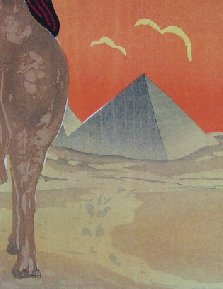
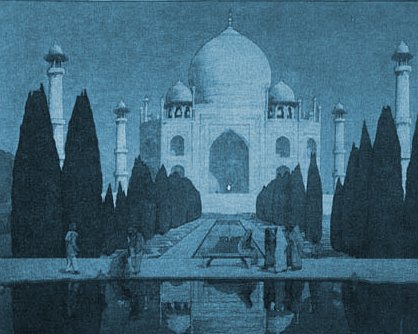
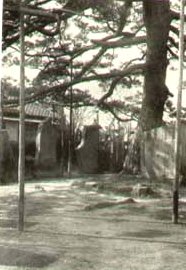
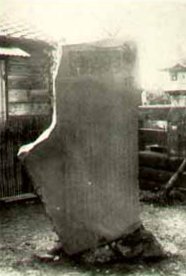
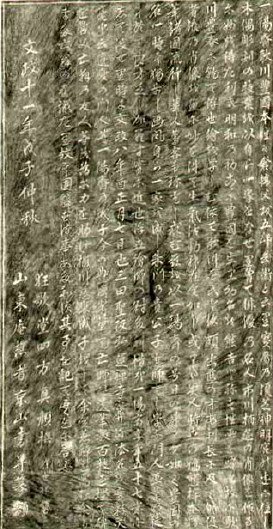
 HOME
HOME